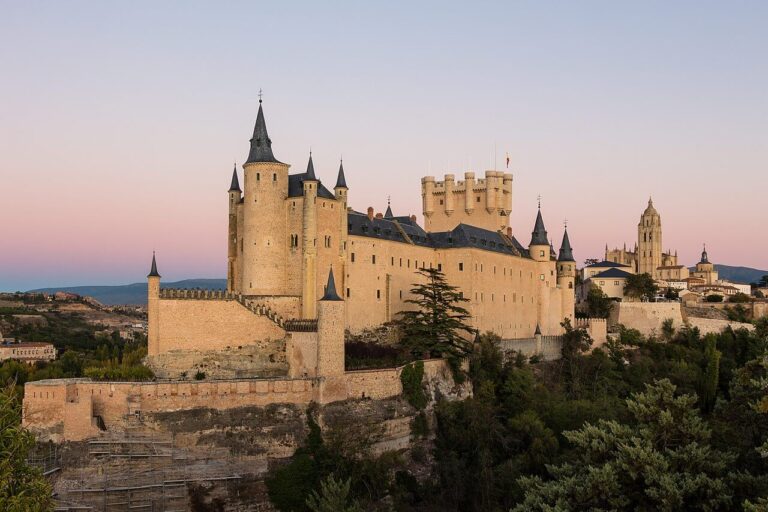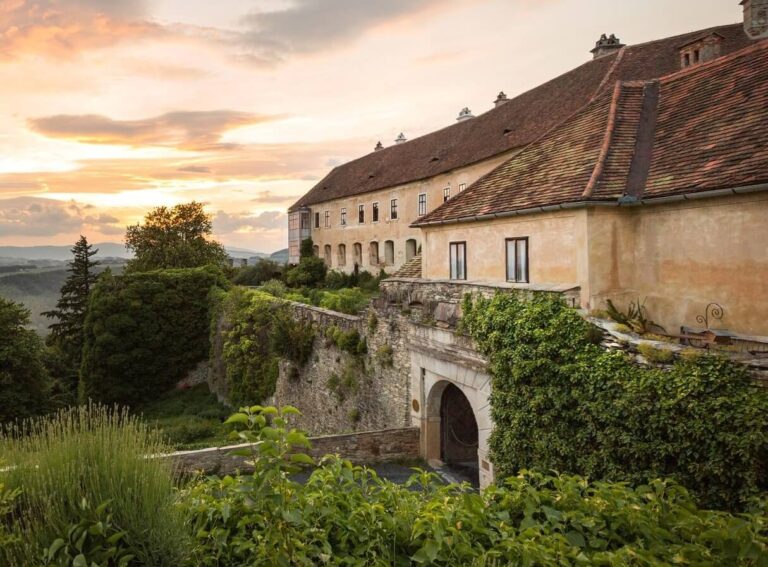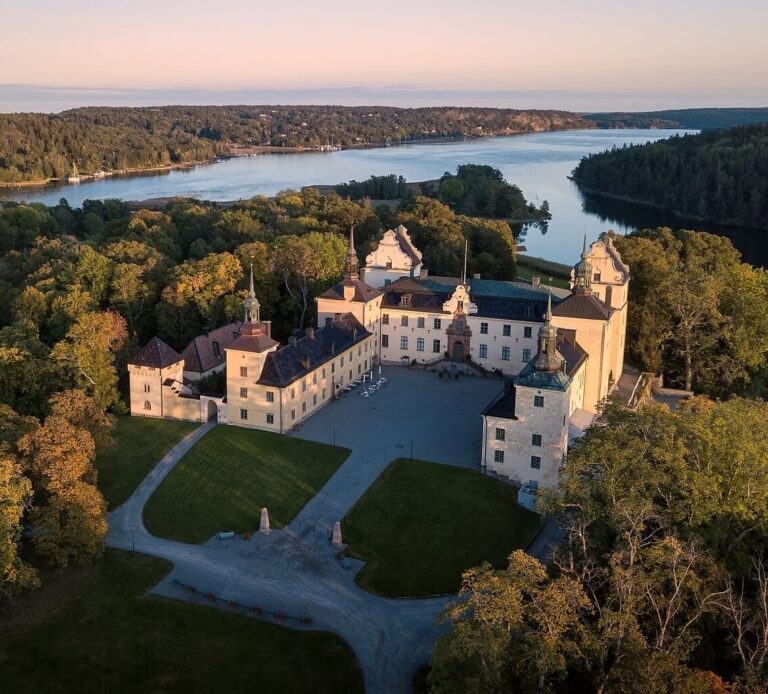The Best Castles and Palaces near Vienna
Vienna is a city rich with Royal history. Therefor you can find many beautiful palaces in and around Vienna.
When you think of Vienna (or Austria in general) it’s highly likely that you are think of Empress Elisabeth, better known as Sisi. But the Habsburgs ruled Austria for hundreds of years.
The House of Habsburg was one of the most prominent Royal dynasties in Europe. And it produces Kings all over Europe. One of their formal seats is the Hofburg Palace which stands in the center of Vienna.
But there are far more palaces in and around Vienna. In this post you’ll find the best palaces in the Vienna region. With at the end a Google Map to make your planning to these palaces even easier.
Schönbrunn Palace
Emperor Leopold I commissioned the building of a hunting lodge for his son, the future Emporer Joseph I, in the 17th century.
But it is in te 18th century that Schönbrunn grew into the impressive palatial imperial residence you can visit today.
During the reign of Maria Theresa, Schönbrunn became the official Summer residence of the Habsburg family. Thereby it became the focus of court life.

Schönbrunn Palace has 1441 rooms. But of course you can’t visit all of them. 40 rooms in the Palace are open to visitors of Schönbrunn.
These rooms include the State Rooms and private apartments of Emperor Franz Joseph and Elisabeth (Sisi). But you can also see the 18th century interiors from Maria Theresa’s reign.

The grounds of Schönbrunn Palace are extensive. They include several gardens (a privy garden and orangery garden), the Gloriette, a maze, a Palm House, a vineyard and a Zoo.
From the Gloriette you have a wonderful view over the Palace and the grounds. It also houses a café.
Visit Schönbrunn Palace
The Palace and the park are open daily all year long. The gardens, maze & Gloriette are open May-November.
How to get here
Schönbrunn Palace is located just outside Vienna. You can easily get here by metro (line U4) which takes approximaly 15 minutes from the city center.
The tram (10 & 60) and bus (10A) also ride past Schönbrunn
Hofburg
The Hofburg is the former principal imperial residence of the Habsburg dynasty. And also the official Winter residence of the Habsburgs (Schönbrunn Palace being the Summer residence). It is, among others, the birth place of Marie Antoinette, the last Queen of France.
The building of Hofburg started in the 13th century and has been extended multiple times up untill the 20th century.
Currently the Hofburg is the official residence and workplace of the President of Austria. But it also houses several museum and a congress center.
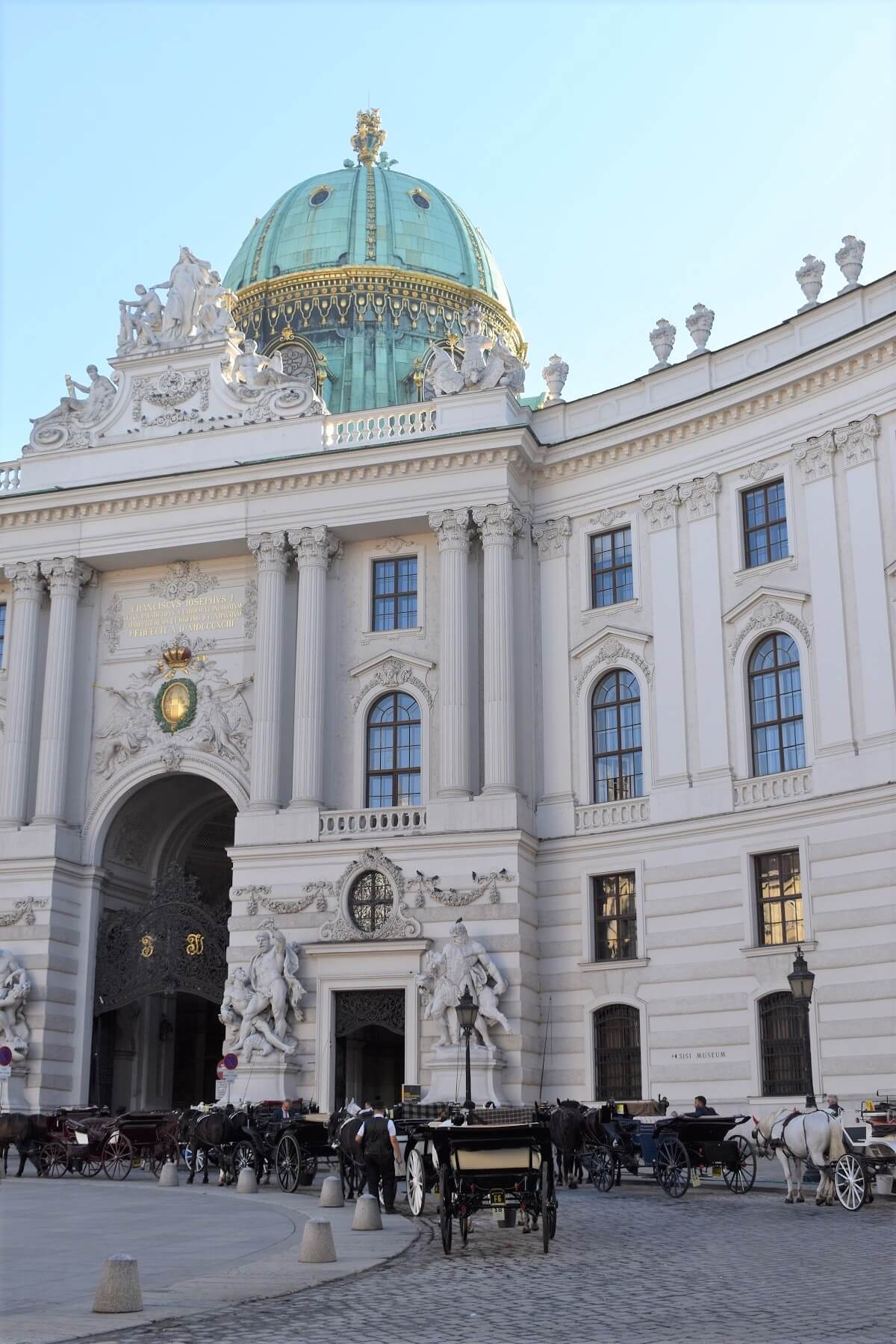
While many will think of the Hofburg as only the St. Michael’s Wing (pictured above) it is actually an expansive building divided over several wings and built over many centuries.
Many of these wings of the Hofburg you can visit.
St. Michael’s Wing
One of the most iconic buildings in Vienna is the St. Michael’s Wing of the Hofburg Palace. This wing houses the Sisi Museum which is divided over three sections: The Sisi Museum, the Imperial Apartments and the Silver Collection.
Stallburg
Originally built as the imperial mews and as residence for Crown Prince Maximilian. It later houses the art collection of Archduke Leopold Wilhelm (which can now be seen in the Kunsthistorisches Museum).
Stallburg is one of few remaining Renaissance buildings in Vienna. Today, the Lipizzaners of the Spanish Riding School still occupy the building.
Court Library (Hofbibliothek)
In 1722 Charles VI authorised the building of the Imperial Court Library. The State Hall is the largest Baroque library in the world.
In the library you will find the large book collection of Prince Eugene of Savoy.
On the ceiling are beautiful paintings by court painter Daniel Gran. And in the collection you can find one of the largest collections of Martin Luther’s writings from the Reformation Era.
Currently the Court Library is the Austrian National Library.
Visit the Austrian National Library:
The State Hall, Literature, Papyrus, Globe and Esperanto Museum are open Tuesday-Sunday
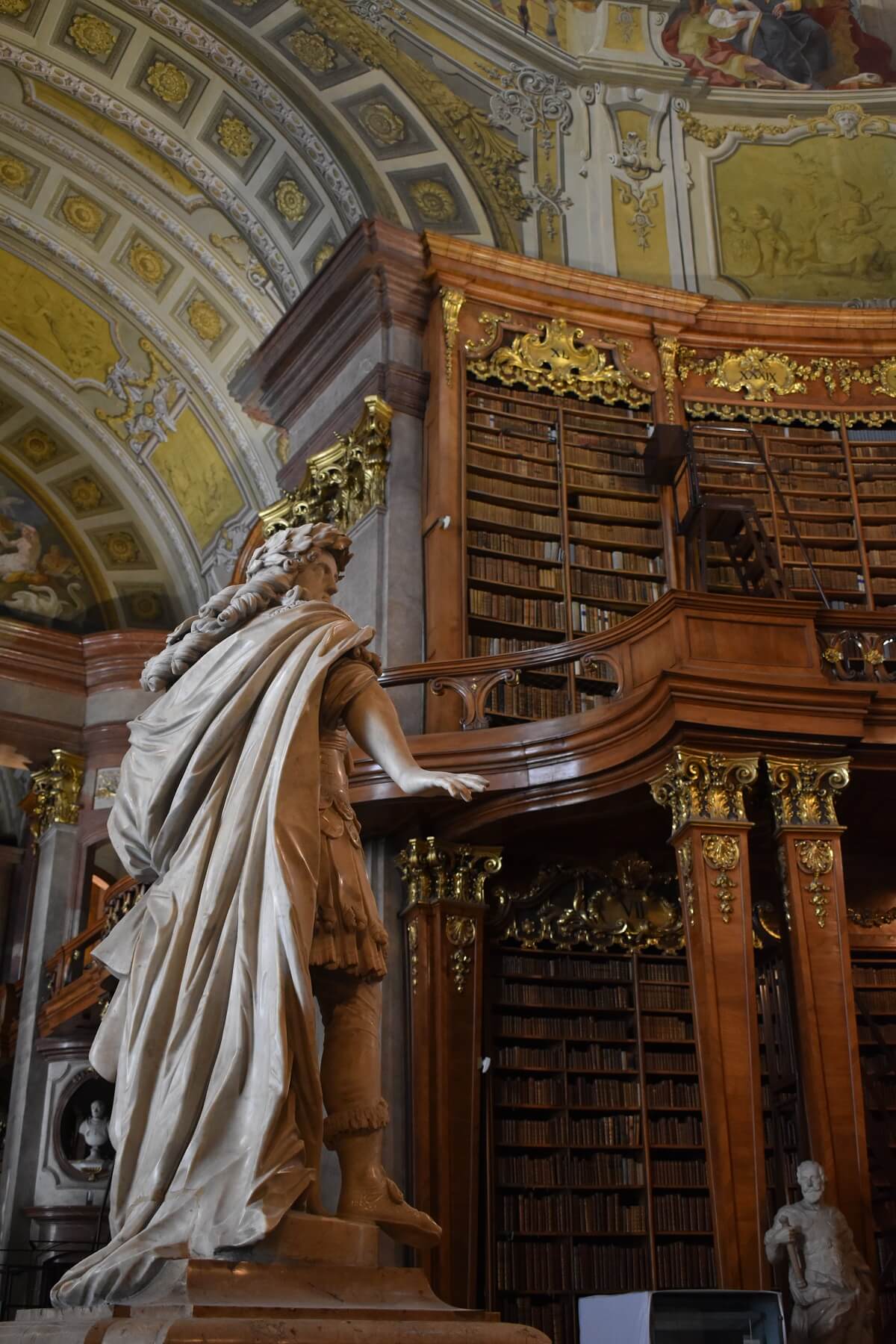
Palais Archduke Albrecht (Albertina)
Connected to the Augustinan Monestry stands the Palais Archduke Albrecht. In the early 19th century some members of the imperial family lived in this Palace.
Currently the Palais Archduke Albrecht is part of the Albertina Museum. At the Albertina you can visit Habsburg State Rooms (next to a large art collection)

Belvedere Palace
In the early 18th century Prince Eugene of Savoy commissioned Baroque architect Johann Lukas von Hildebrandt to built him a Summer residence.
Belvedere Palace consist of 2 Baroque Palaces. In 1712 the construction of Lower Belvedere started and in 1717 Upper Belvedere followed.
French garden architect Dominique Girard designed the Baroque park, using techniques of water technology and garden design which he acquired while working on Versailles.
Upper Belvedere’s Marble Hall has a fresco painted by Carlo Carlone.

For a time in the 18th century Maria Theresa turned Upper Belvedere in a museum showcasing the Imperial Picture Gallery.
In 1896 it was decided that Upper Belvedere should become the residence of the heir to the throne Franz Ferdinand. Lower Belvedere became a Modern Art museum.
Today both Lower and Upper Belvedere are museums.
Visit Belvedere Palace
Lower Belvedere is currently closed for renovation.
Upper Belvedere is open daily from 10-6
Schloss Hof
in 1725 Prince Eugene of Savoy bought the estate which at that time was a 17th century citadel with four wings. He extended the building in Baroque style (designed by Johan Lukas von Hildebrandt) with two extra wings. From then, the Palace was used as a hunting lodge.
In 1755 Maria Theresa acquired the Palace after which which the palace was extended even further with an extra floor and the first floor rooms were remodelled.
The gardens are designed after French model by Anton Zinner.
Schloss Niederweiden
On the estate stands another Palace: Schloss Niederweiden. This “chateau” was built in the 17th century as a hunting lodge. And when Prince Eugene of Savoy bought Schloss Hof, he also bought the hunting lodge.
Not until Maria Therese owned both properties did the hunting lodge change. She carried out an extensive renovation of Schloss Niederweiden.
After Maria Theresa’s reign the Palace fell into disrepair. It was not until the late 20th century that the Palace was renovated and saved from ruin. The palace now holds exhibitions and works as an event venue.
Visit Schloss Hof & Niederweiden
Both Palaces are open to the public on daily basis.
How to get here:
From Vienna Central Station you can catch a train to Marchegg Station. There are train connections from Vienna – Mitte/Landstrasse.
At Marchegg station there is a free bus shuttle to Schloss Hof and Schloss Niederweiden.
In the Summer months you can also take the Twin City Liner boat which departs from Vienny City Schwedenplatz and arrives at Hainburg. From there you can take a shuttle bus. *only on Saturday & Sunday
Hermesvilla
Empress Elisabeth called the Hermesvilla the “Palace of Dreams”. The Palace was gifted to Elisabeth by her husband Emperor Franz Joseph in the hope of persuading Elisabeth to spend more time in Vienna.
It is located in the former imperial hunting grounds that are now called the Lainzer Tiergarten.
At the Hermesvilla you can see what domestic life for an Emporer and Empress was like. Through photographs, personal items and original furniture you can immerse yourself in Imperial life.
Visit Hermesvilla
The Hermesvilla is open Tuesday-Sunday. Entry is free for children under the age of 19. On Sunday entry is free for everyone.
Visit more castles and palaces in Austria:
Schloss Laxenburg & Franzensburg
Located around 15km south of Vienna stands Schloss Laxenburg. The residences served as Summer residences for the Habsburg dynasty.
The estate consists of two castles: the 12th century Old Castle and the New Castle (also known as the Blauer Hof).
Surrounding the castles is Austria’s vasted landscaped garden.
Nearby stands another castle. The 19th century Franzensburg Castle is designed in Medieval style and meant as a “garden house”. The castle was never lived in but used as a museum. Even today you can visit the museum Franzensburg.
Visit Schloss Laxenburg
The Laxenburg Park is open daily. From the park there’s a shuttle service to Franzensburg.
Several bus lines ride past Laxenburg. For public transport information take a look at the ÖBB website
Burg Liechtenstein
Castle Liechtenstein is located on the southern edge of the Vienna Woods. It is the family seat of the Prince of Liechtenstein
The castle was originally built in the 12th century but got destroyed by the Ottoman’s. It wasn’t until the 19th century that it got rebuilt.
Visit Burg Liechtenstein
The castle can only be visited through guided tour on selected days.
Burg Kreuzenstein
Count Nepomuk Wilczek rebuilt the castle in the 19th century on the remains of a Medieval castle. The castle is rebuilt with materials from medieval structures around Europe to make it authentic looking.
Visit Burg Kreuzenstein
The castle is open to visitors from April-November
Are you planning on visiting one of these palaces in and around Vienna? Make sure to share it with #visiteuropeancastles for a chance to be featured on our socials.



